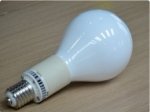I summarized some advantages of induction lamps compared with conventional LED lamps as your requirements.
Induction lamps have a lifespan of 80,000 to 100,000 hours (depending on type and model), which is essentially almost the same as LED lamp lifespan. However, the lumen degradation will be around 14% for LED lamp after 1200 hours use because of the problem of heat dissipation. The lumen degradation of induction lamp is only 16% after 20000 hours use. Another thing is about luminous efficiency. For LED, the system luminous efficiency is around 65LM/W, while for induction lamp, it is over 75LM/W, especially for 400W induction lamp, it will be 80LM/W. The major difference between the technologies is in conversion efficiency (energy utilization) and costs.
Most presently available commercial LED lighting fixtures have conversion efficiencies in the 35 to 55 Lumens/Watt (L/W) range. LED elements with a conversion efficiency of 70 L/W are available, but still quite expensive. There are reports of LEDs with conversion efficiencies of up to 100 L/W operating in research labs, but they are not yet commercially available.
Induction lamps have a conversion efficiency ranging from 65 L/W in low wattage (8 ~ 20 W internal inductor types) to 85 L/W in the high wattage (250 ~ 400 W external inductor models) range. Ongoing research will see some small improvements in these numbers. When considering commercial/industrial lighting and using a 200 W fixture as an example, the induction lamp version will produce 17,000 Lumens while an LED version would only produce 11,000 Lumens (about 35% less light) with the same energy input.
Additionally, the higher operating frequency of induction lamp makes the light stable and no flickering.
Above are just a few obvious advantages of induction lamps compared with LED ones. If you want to know more about indution lamps, I will be very glad to help.



